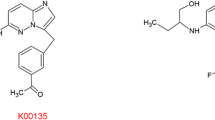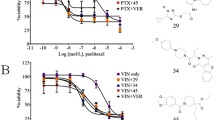Abstract
Purpose
The development of multi-drug resistance (MDR) due to the expression of members of the ATP binding cassette (ABC) transporter family is a major obstacle in cancer treatment. The broad range of substrate specificities associated with these transporters leads to the efflux of many anti-cancer drugs from tumour cells. Therefore, the development of new chemotherapeutic agents that are not substrates of these transporters is important. We have recently demonstrated that some members of a novel series of pyrrolo-1,5-benzoxazepine (PBOX) compounds are microtubule-depolymerising agents that potently induce apoptosis in several cancer cell lines and impair growth of mouse breast tumours. The aim of this current study was to establish whether PBOXs were capable of inducing apoptosis in cancer cells expressing either P-glycoprotein or breast cancer resistance protein (BCRP), two of the main ABC transporters associated with MDR.
Methods
We performed in vitro studies to assess the effects of PBOXs on cell proliferation, cell cycle and apoptosis in human cancer cell lines and their drug-resistant substrains expressing either P-glycoprotein or BCRP. In addition, we performed a preliminary molecular docking study to examine interactions between PBOXs and P-glycoprotein.
Results
We established that three representative PBOXs, PBOX-6, -15 and -16 were capable of inducing apoptosis in drug-resistant HL60-MDR1 cells (expressing P-glycoprotein) and HL60-ABCG2 cells (expressing BCRP) with similar potencies as in parental human promyelocytic leukaemia HL60 cells. Likewise, resistance to PBOX-6 and -16 was not evident in P-glycoprotein-expressing A2780-ADR cells in comparison with parent human ovarian carcinoma A2780 cells. Finally, we deduced by molecular docking that PBOX-6 is not likely to form favourable interactions with the substrate binding site of P-glycoprotein.
Conclusion
Our results suggest that pro-apoptotic PBOX compounds may be potential candidates for the treatment of P-glycoprotein- or BCRP-associated MDR cancers.






Similar content being viewed by others
References
Mulligan J, Greene LM, Cloonan S et al (2006) Identification of tubulin as the molecular target of pro-apoptotic pyrrolo-1, 5-benzoxazepines. Mol Pharmacol 70:60–70
Zisterer DM, Campiani G, Nacci V et al (2000) Pyrrolo-1, 5-benzoxazepines induce apoptosis in HL-60, Jurkat, and Hut-78 cells: a new class of apoptotic agents. J Pharmacol Exp Ther 293:48–59
Mc Gee MM, Campiani G, Ramunno A et al (2001) Pyrrolo-1, 5-benzoxazepines induce apoptosis in chronic myelogenous leukemia (CML) cells by bypassing the apoptotic suppressor bcr-abl. J Pharmacol Exp Ther 296:31–40
Mc Gee MM, Hyland E, Campiani G et al (2002) Caspase-3 is not essential for DNA fragmentation in MCF-7 cells during apoptosis induced by the pyrrolo-1, 5-benzoxazepine, PBOX-6. FEBS Lett 515:66–70
Mc Gee MM, Campiani G, Ramunno A et al (2002) Activation of the c-Jun N-terminal kinase (JNK) signaling pathway is essential during PBOX-6-induced apoptosis in chronic myelogenous leukemia (CML) cells. J Biol Chem 277:18383–18389
Mc Gee MM, Greene LM, Ledwidge S et al (2004) Selective induction of apoptosis by the pyrrolo-1, 5-benzoxazepine 7-[[dimethylcarbamoyl]oxy]-6-(2-naphthyl)pyrrolo-[2, 1-d] (1, 5)-benzoxazepine (PBOX-6) in Leukemia cells occurs via the c-Jun NH2-terminal kinase-dependent phosphorylation and inactivation of Bcl-2 and Bcl-XL. J Pharmacol Exp Ther 310:1084–1095
McElligott AM, Maginn EN, Greene LM et al (2009) The novel tubulin targeting agent, pyrrolo-1, 5-benzoxazepine-15, induces apoptosis in poor prognostic subgroups of Chronic Lymphocytic Leukemia. Cancer Res 69:8366–8375
Nathwani SM, Butler S, Meegan MJ et al (2010) Dual targeting of tumour cells and host endothelial cells by novel microtubule-targeting agents, pyrrolo-1, 5-benzoxazepines. Cancer Chemother Pharmacol 65:289–300
Greene LM, Fleeton M, Mulligan J et al (2005) The pyrrolo-1, 5-benzoxazepine, PBOX-6, inhibits the growth of breast cancer cells in vitro independent of estrogen receptor status, and inhibits breast tumour growth in vivo. Oncol Rep 5:1357–1363
Mashima T, Seimiya H, Chen Z et al (1998) Apoptosis resistance in tumour cells. Cytotechnology 27:293–308
Cowan KH, Batist G, Tulpule A et al (1986) Similar biochemical changes associated with multidrug resistance in human breast cancer cells and carcinogen-induced resistance to xenobiotics in rats. Proc Natl Acad Sci USA 83:9328–9332
Redmond SM, Joncourt F, Buser K et al (1991) Assessment of P-glycoprotein, gluthathione-based detoxifying enzymes and O6-alkylguanine-DNA alkyltransferase as potential indicators of constitutive drug resistance in human colorectal tumours. Cancer Res 51:2092–2097
Eijdems EW, de Haas M, Timmerman AJ et al (1995) Reduced topoisomerase II activity in multidrug-resistant human non-small cell lung cancer cell lines. Br J Cancer 71:40–47
Sarkadi B, Homolya L, Szakacs G et al (2006) Human multidrug resistance ABCB and ABCG transporters: participation in a chemoimmunity defence system. Physiol Rev 86:1179–1236
Maliepaard M, Scheffer GL, Faneyte IF et al (2001) Subcellular localisation and distribution of the breast cancer resistance protein transporter in normal human tissues. Cancer Res 61:3458–3464
Scheffer GL, Maliepaard M, Pijnenborg AC (2000) Breast cancer resistance protein is localized at the plasma membrane in mitoxantrone- and topotecan-resistant cell lines. Cancer Res 60:2589–2593
Juliano RL, Ling V (1976) A surface glycoprotein modulating drug permeability in Chinese hamster ovary cell mutants. Biochim Biophys Acta 455:152–162
Zaman GJR, Flens MJ, van Leusden MR et al (1994) The human multidrug resistance-associated protein MRP is a plasma membrane drug-efflux pump. Proc Nat Acad Sci 91:8822–8826
Doyle LA, Yang W, Abruzzo LV et al (1998) A multidrug resistance transporter from human MCF-7 breast cancer cells. Proc Natl Acad Sci USA 95:15665–15670
Sarkadi B, Ozvegy-Laczka C, Nemet K et al (2004) ABCG2—a transporter for all seasons. FEBS Lett 567:116–120
Nakatomi K, Yoshikawa M, Oka M (2001) Transport of 7-ethyl-10-hydroxycamptothecin (SN-38) by breast cancer resistance protein ABCG2 in human lung cancer cells. Biochem Biophys Res Commun 288:827–832
Schellens JH, Maliepaard M, Scheper RJ et al (2000) Transport of topoisomerase I inhibitors by the breast cancer resistance protein. Potential clinical implications. Ann NY Acad Sci 922:188–194
Volk EL, Schneider E (2003) Wild-type breast cancer resistance protein (BCRP/ABCG2) is a methotrexate polyglutamate transporter. Cancer Res 63:5538–5543
Borowski E, Bontemps-Gracz MM, Piwkowska A (2005) Strategies for overcoming ABC-transporters-mediated multidrug resistance (MDR) of tumour cells. Acta Biochim Pol 52:609–627
Ozvegy-Laczka C, Hegedus T, Varady G et al (2004) High-affinity interaction of tyrosine kinase inhibitors with ABCG2 multidrug transporter. Mol Pharmacol 65:1485–1495
Campiani G, Nacci V, Fiorini I et al (1996) Synthesis, biological activity, and SARs of pyrrolobenzoxazepine derivatives, a new class of specific “peripheral-type” benzodiazepine receptor ligands. J Med Chem 39:3435–3450
Penzotti JE, Lamb ML, Evensen E et al (2002) A computational ensemble pharmacophore model for identifying substrates of P-glycoprotein. J Med Chem 45:1737–1740
Aller SG, Yu J, Ward A et al (2009) Structure of P-glycoprotein reveals a molecular basis for poly-specific drug binding. Science 323:1718–1722
Greene LM, Campiani G, Lawler M et al (2008) BubR1 is required for a sustained mitotic spindle checkpoint arrest in human cancer cells treated with tubulin-targeting pyrrolo-1, 5-benzoxazepines. Mol Pharmacol 73:419–430
Verma NK, Dempsey E, Conroy J et al (2008) A new microtubule-targeting compound PBOX-15 inhibits T-cell migration via post-translational modifications of tubulin. J Mol Med 86:457–469
Greene LM, Kelly L, Onnis V et al (2007) STI-571 enhances the apoptotic efficacy of PBOX-6, a novel microtubule targeting agent, in both STI-571-sensitive and -resistant Bcr-Abl-positive human chronic myeloid leukemia cells. J Pharmacol Exp Ther 321:288–297
Mollinedo F, Gajate C (2003) Microtubules, microtubule-interfering agents and apoptosis. Apoptosis 8:413–450
Toffoli G, Simone F, Corona G et al (1995) Structure activity relationship of verapamil analogues and reversal of multidrug resistance. Biochem Pharmacol 50:1245–1255
Rabindran SK, He H, Singh M et al (1998) Reversal of a novel multidrug resistance mechanism in human colon carcinoma cells by fumitremorgan C. Cancer Res 58:5850–5858
Rabindran SK, Ross DD, Doyle LA et al (2000) Fumitremorgan C reverses drug resistance in cells transfected with breast cancer resistance protein. Cancer Res 60:47–50
Seelig A, Landwojtowicz E (2000) Structure-activity relationship of P-glycoprotein substrates and modifiers. Eur J Pharm Sci 12:31–40
Morris PG, Fornier MN (2008) Microtubule active agents: beyond the frontier. Clin Cancer Res 14:7167–7172
Bacher G, Nickel B, Emig P et al (2001) D-24851, a novel synthetic microtubule inhibitor, exerts curative antitumoral activity in vivo, shows efficacy toward multidrug-resistant tumour cells, and lacks neurotoxicity. Cancer Res 61:392–399
Wienecke A, Bacher G (2009) Indibulin, a novel microtubule inhibitor, discriminates between mature neuronal and nonneuronal tubulin. Cancer Res 69:171–177
Acknowledgments
This project was kindly funded by Science Foundation Ireland. In addition, the Molecular Design Group gratefully acknowledges the generous academic support afforded by the Chemical Computing Group (MOE software), OpenEye Scientific (OpenEye product suite), The Trinity Centre for High Performance Computing and Accelrys (Pipeline Pilot) in the delivery of this work.
Author information
Authors and Affiliations
Corresponding author
Rights and permissions
About this article
Cite this article
Nathwani, SM., Butler, S., Fayne, D. et al. Novel microtubule-targeting agents, pyrrolo-1,5-benzoxazepines, induce apoptosis in multi-drug-resistant cancer cells. Cancer Chemother Pharmacol 66, 585–596 (2010). https://doi.org/10.1007/s00280-009-1200-9
Received:
Accepted:
Published:
Issue Date:
DOI: https://doi.org/10.1007/s00280-009-1200-9




